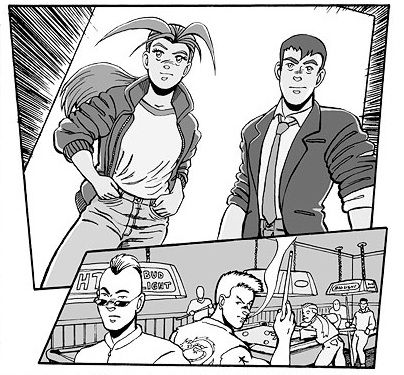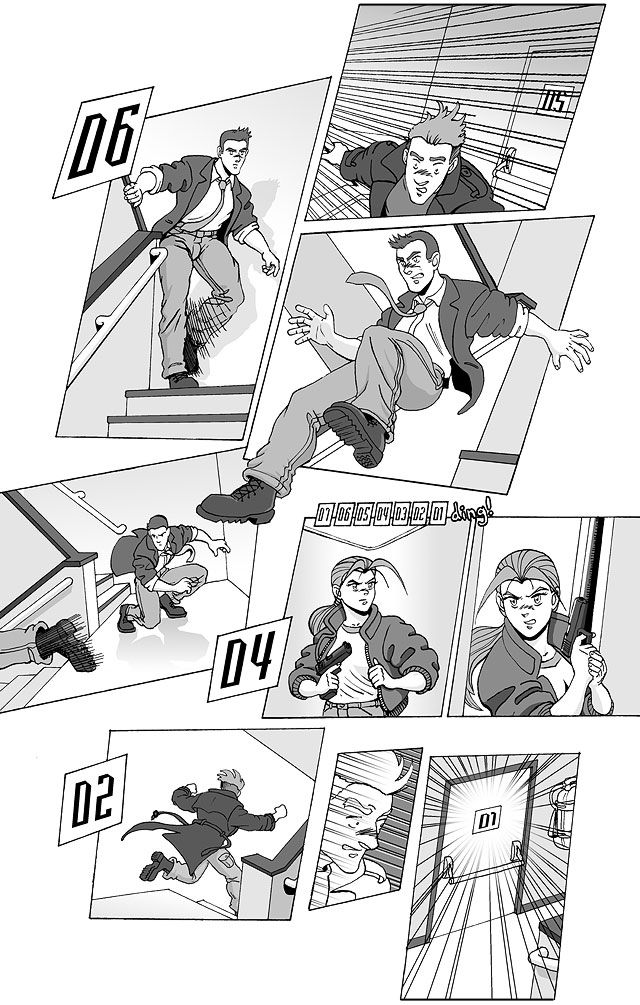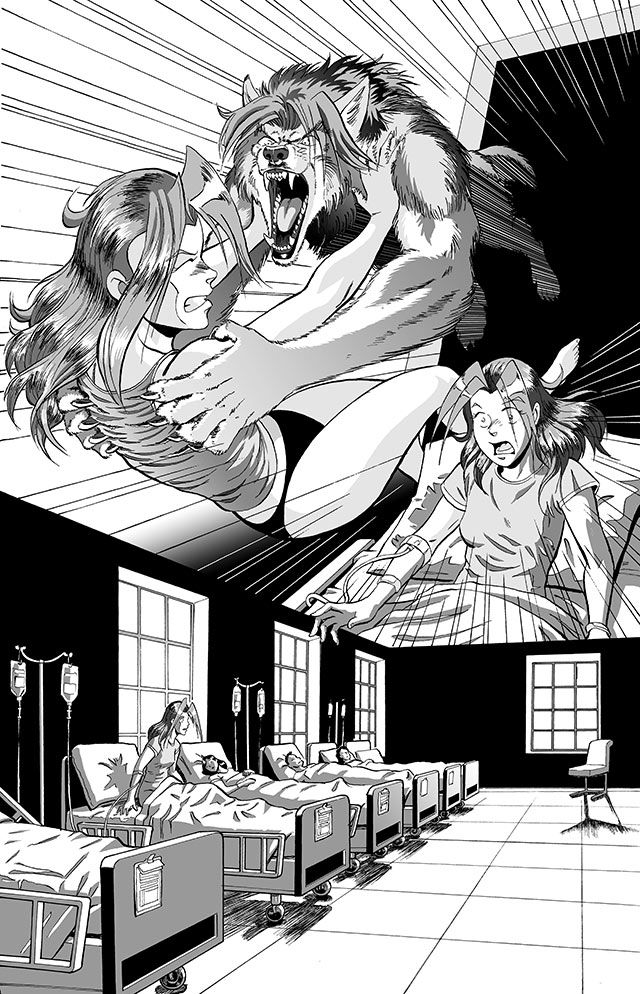Paradigm Shift
By Dirk Tiede
Paradigm Shift starts out like any other buddy-cop story, with donuts, wisecracks, and corpses turning up in the bushes, but halfway through, it lives up to its name and crosses over into darker territory.
In the beginning, the detectives in question, Kate McAllister and Mike Stuart, are as smooth as they come. They have their differences—Kate’s a bit tougher, Mike’s a bit cooler—but their relationship runs on easy patter and unspoken coordination. Tiede is subtle, introducing Kate’s demons a little at a time—a sudden flash of dizziness, a wound that heals too quickly—but as the story goes on, we see her unravel more and more until it’s hard to say what is nightmare and what is real. Mike, on the other hand, starts out as an understated character, but his quietness conceals his strength. Again, there is a slow build; his offhand mentions of martial arts and Zen Buddhism foreshadow his full development as a character later in the story.
Warning: Spoilers ahead.
The central mystery of this series is a series of murders that seem to be done by a wild animal—the victims’ necks are snapped and their bodies are severely clawed. The medical examiner is convinced that only an animal could have inflicted this particular type of wound, but Kate isn’t so sure, and her intuition leads her to believe that a human is behind the murders. As the case goes on, her insights become too good—in nightmares and blackouts she becomes a werewolf, and as the story goes on, it gets harder to sort out dream from reality. By the most recent episodes, Kate is staring at the possibility that she herself may be one of the murderers.
That possibility is the paradigm shift of the title. As in all good cop stories, Tiede spends a lot of time developing a cast of characters with different personalities—Gina, the uptight medical examiner; Ed and Vince, the tough-guy detectives from a different precinct; the beleaguered captain—a whole ecosystem of cops that are bound together despite their personality conflicts. Kate may be a bit of a loose cannon, but she works with her partners, protecting them in times of danger. The thought that she might have an alternate self is shattering, and she tries to bury it, with decreasing success as the story goes on.
Tiede is an excellent storyteller, and the central mystery is a good one that he develops well, but the subplot (which begins the story) is flabby. Kate and Mike find out that Alfonse, a known bad guy, is living in a posh building on the Magnificent Mile, so they go pay him a visit. Kate’s protestation aside, renting a fancy apartment is not probable cause for anything. A pal comes to the door, Alfonse warns him off, and the detectives chase him, Mike taking the stairs, Kate taking the elevator. It’s a great scene—Tiede’s scattered, slanted panels made me feel like I was hurtling down 12 floors—but at the end, when they haul the bad guys off to the police station, I still wasn’t sure what anyone had done. Similarly, the interrogation scene, in which Tiede uses symmetrically arranged panels to show Kate and Mike questioning the two suspects in separate rooms—is beautifully laid out, but they seem to be fishing around. This part of the story seems to be a case of form over function—there are great fights, chase scenes, the interrogation of a hospitalized suspect in Mandarin, all beautifully drawn, but the underlying plot lacks enough detail to be convincing. It seems like it's just an excuse for some kickass fight scenes, although there are hints that it will tie into the other storyline by the end.
Also, Tiede wrote this comic over a period of years, and naturally his style develops over the course of the story. Kate's nightmare sequences are some of the strongest pages in the comic, in terms of composition and art as well as storytelling.
Paradigm Shift has a manga look to it; Kate’s hair is straight out of Akihabara, and Tiede uses sound effects, speed lines, and other standard manga techniques. His style is fairly mature, though, close to the look of seinen (young men’s) manga in Japan. And he avoids the two standard bugaboos of global manga creators, overusing screentones and using character design to mask weaknesses in basic anatomy. Tiede’s figures are stylized, but they are also solid, if a bit stiff in places. Most of the time they move convincingly, and the action scenes are nicely choreographed.
Where Tiede's technique really shines, though, is in the composition of his pages and his creative use of different panel shapes and formats to advance the story. He breaks the action into small panels and pulls back for the big picture; he overlaps the panels in creative ways, and he uses diagonals and diamond-shaped panels both for action scenes and for strong emotions. These techniques pull the reader through the story and also result in pages that are quite beautiful in their own right, as works of art.
Paradigm Shift is set in Chicago, and each chapter is set in a specific area of the city. While his backgrounds are cleaner than the real thing, Tiede has a good sense of the architecture and the feel of the different parts of the city, and many of his establishing shots are lovely, even the drawings of the grittier areas.
Although Paradigm Shift is a webcomic, it looks better in print. I bought the first two volumes at NYAF and was very pleased with my purchase; Tiede really knows how to put a book together. A lot of self-published comics look like crap (paper that’s too white, iffy print quality). Tiede picked a nice, creamy paper with a bit of texture for his books, and the lines are smoother in the book than on the web, where the diagonals take on a jagged look. More importantly, the pages in the book are presented as single pages, whereas online Tiede lays out each chapter as one long vertical scroll. That makes a difference: Online, because of Tiede’s creative paneling, the page breaks are not as obvious, so it’s hard to grasp each page as a unit. And of course the pages are a bit longer than my monitor is deep, so I can’t see the entire page at once. All that goes away in the book. What’s more, Tiede loads his books with extras—character bios, notes on the setting and action, even a comics drawing tutorial. It’s like getting the director’s cut, with extra commentary.
As I write this, the online story is drawing to a close, and I feel the same way I do toward the end of a Preston Sturges film: The characters have gone so far from their starting points that I don’t see how this could possibly end. Unfortunately, Tiede doesn’t seem to have updated the comic in a couple of months. With the denouement so close, I hope he picks up the pen pretty soon and wraps up this story. Then I’m going to track him down and buy the third volume, because it really is that good.



